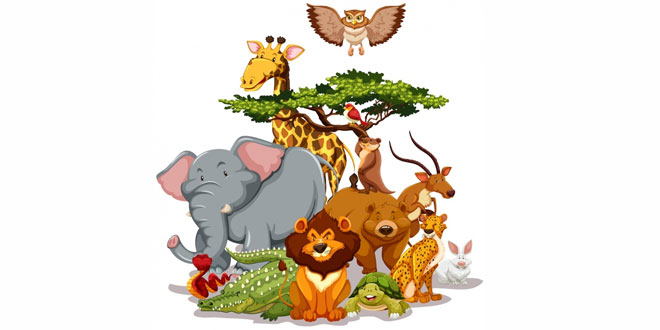Weather, Climate and Adaptations of Animals to Climate [Page 2]
Question: What happens due to the tilt of the Earth and how would the Earth be affected if it were not tilted?
Answer: The Earth’s axis is not perpendicular to the plane of its orbit. It is inclined at an angle of 23.5°. This causes the northern hemisphere to receive the maximum direct sunlight. Thus, it gets more hours of daylight in June than in December when it receives lesser direct sunlight and lesser hours of daylight. This causes different seasons in a year. In contrast, in the southern hemisphere the seasons are reversed. When the seasons are reversed in the southern hemisphere, the North Pole is tilted away from the sun; the South Pole is tilted towards it therefore, it is summer in the southern hemisphere.
If the Earth did not have a tilt, there would be no seasons and day and night would be of the same length all through the year. The amount of solar energy reaching any given location on Earth would also be constant throughout the year.
Weather, Climate and Adaptations of Animals to Climate – Question: How does the Arctic fox prevent heat loss from its body?
Answer: The long white fur of the arctic fox, commonly known as snow fox, camouflages it from predators and protects it from cold. During warmer months, the coat colour changes to brown, blending with the environment. The small and round ears, nose and paws of the fox help in preventing heat loss from the body.
Question: What are the common adaptations in animals living in hot tropical and temperate climates.
Answer: Tropical climates are very hot and humid, while temperate climates are quite warm. In tropical climates, there is abundant rainfall and considerable amount of sunshine. Animals living in these climates are adapted to cope with the heat.
- Elephants have large ears that help to radiate heat from the body. They usually swim to cool off during extreme hot weather and also use their trunks to sprinkle water on their backs.
- Most monkeys such as the lion-tailed macaque and some apes are smaller in size than other animals, which helps them lose heat more easily.
- Tigers and lions usually live closer to the water bodies to stay cooler and swim during the day.
- Many insects and snakes stay inside holes in the ground, which keeps their bodies cool. Most animals live in tunnels, holes or caves which are much cooler, keeping the animals away from the scorching heat.
- Some animals are nocturnal (active during the night) to avoid the heat of the day. They are active only during the early hours of the night and sleep in their burrows in the daytime to escape the heat. Some animals sleep throughout the summer months. This long summer sleep is called aestivation.
- Some animals such as lizards are adapted to being heat-tolerant. Many animals are adapted to live on trees as the leaves from the trees keep the air around them much cooler.
- The sticky-pads on the feet of some animals such as red-eyed frog help in climbing trees on which they live.
- Most herbivorous animals live on fruits, seeds, young leaves, stems, flowers and buds, which have a high water content to replenish their bodies with water in the hot climates.
Question: What are the common adaptations in animals living in extremely cold climates.
Answer: The polar regions are at the farthest distance from the equator and receive the least amount of sunlight. The temperatures are freezing all throughout the year. The soil is covered with snow and thick layers of ice in most of the areas. Animals found in extremely cold climates are the polar bear, arctic fox, penguins, arctic tern, killer whale, snow goose, beluga whale and seal.
- Migration: Animals such as the caribou, which are not able to cope with the cold, migrate to warmer places such as the Alaskan forests during the winter months. Snow geese fly away to Japan and the arctic terns fly to Antarctica to breed.
- Hibernation: It is the process of remaining in an inactive state (which resembles deep sleep) in certain animals living in cold climates during winter. Hibernation protects the animals from the cold and reduces the need for food when food is scares. The animals that hibernate during winters are polar bear, skunk, chipmunk etc.
- Polar bears have wide and large paws, which help them to swim and walk on the snow with ease. They can close their nostrils while under water and stays there for a long time. they also have strong sense of smell and can identify their prey from huge distances. The thick layer of fur in polar bears insulates them from the cold. They also have thick layer of fat, called blubber, under their skin, which keeps them warm.
- Seal and penguin also have a layer of blubber under their skin, which insulates their body from cold. The fat also provides energy to the animals when there is scarcity of food. The whiskers are used by them to feel and locate fish in murky or deep water. They have two layers of fur, one close to the body and the other is a longer one as a waterproof layer which not only keeps them warm, but also gives their streamlined body an advantage while swimming. The claws help in grooming the outer fur. The flippers help in blood circulation and regulating the body temperature from time to time.
- The long white fur of the arctic fox, commonly known as snow fox, camouflages it from predators and protects it from cold. During warmer months, the coat colour changes to brown, blending with the environment. The small and round ears, nose and paws of the fox help in preventing heat loss from the body.
 Class Notes NCERT Solutions for CBSE Students
Class Notes NCERT Solutions for CBSE Students


